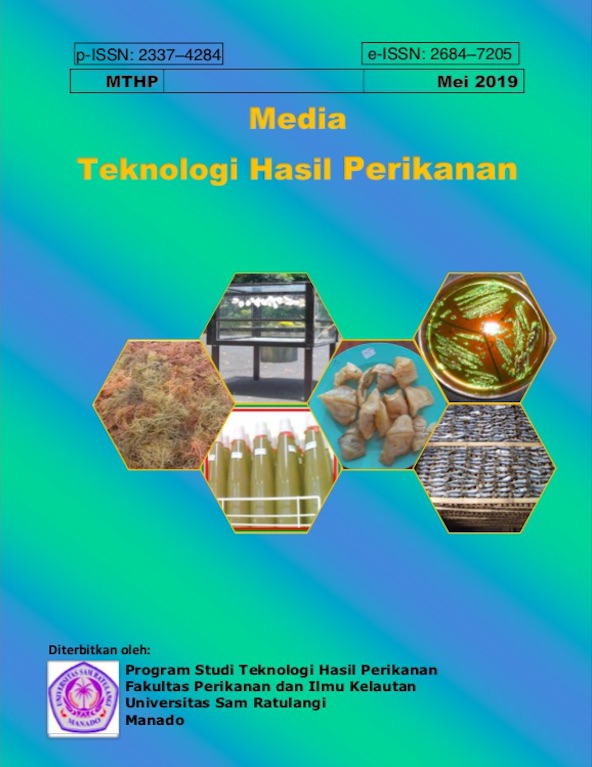PENGUJIAN KAPANG DAN BAKTERI PATOGEN PADA IKAN KAYU (KATSUOBUSHI) ASAP CAIR SELAMA PENYIMPANAN
DOI:
https://doi.org/10.35800/mthp.7.2.2019.23618Keywords:
Wood Fish, Liquid Smoke, Microbes, Ikan Kayu, Asap Cair, MikrobaAbstract
Wooden fish products that are usually processed traditionally have a weakness, namely deposit of tar in food ingredients which endangers health and air pollution that is not environmentally friendly. Today's wood processing is the high content of Polycyclic Aromatic Hydrocarbons (PAH), especially benzopirene which can cause cancer, as an alternative to wood fish processing conducted research using liquid smoke wood fogging technology. The purpose of this study is to calculate the presence of molds and pathogenic bacteria that can contaminate processed fishery products, namely wood fish. The microbial test results showed that the mold value in the lowest range was 2.0x102 on day 0 with a concentration of 4% soaking 30 minutes and the highest value was 1.4x103 on the 30th day with a concentration of 2% immersion 120 minutes. The total plate number of fresh skipjack with a value of 5.8x104 cfu/gram and after being processed into wood fish the lowest ALT value is 2.9x102 cfu/gram on day 0 with a concentration of 2% 120 minutes soaking and a high value of 9.9x102 cfu/gram on the 30th day with a concentration of 8% soaking 30 minutes, testing of pathogenic bacteria showed negative results (none). Chemical testing showed that the lowest water content value was 13% on day 0 with a concentration of 6% and the highest value was 17.25% on day 30 concentration of 2% soaking and 120 minutes. The lowest pH value is 5.38 on day 0 with a concentration of 2% 120 minutes soaking and the highest value is 5.96 on day 15 with a concentration of 2% soaking 30 minutes. The test results showed significant results in the ANOVA test.
Keyword: Wood Fish, Liquid Smoke, Microbes.
Â
Produk ikan kayu yang biasa diolah secara tradisional memiliki kelemahan yaitu terdepositnya tar pada bahan makanan sehingga membahayakan kesehatan serta adanya polusi udara yang tidak ramah lingkungan. Pengolahan ikan kayu dewasa ini adalah tingginya kandungan senyawa Polycyclic Aromatic Hydrocarbon (PAH) terutama benzopiren yang dapat menyebabkan kanker, sebagai alternatif dalam pengolahan ikan kayu dilakukan penelitian menggunakan teknologi pengasapan ikan kayu asap cair. Tujuan penelitian ini untuk menghitung keberadaan kapang dan bakteri patogen yang dapat mengkontaminasi produk olahan hasil perikanan yaitu ikan kayu. Hasil pengujian mikroba menunjukkan bahwa nilai kapang pada range paling terendah yaitu 2,0x102 pada hari ke 0 dengan konsentrasi 4% perendaman 30 menit dan nilai tertinggi yaitu 1,4x103 pada hari ke 30 dengan konsentrasi 2% perendaman 120 menit. Angka Lempeng total ikan cakalang segar dengan nilai 5,8x104 cfu/gram dan setelah diolah menjadi ikan kayu nilai ALT terendah yaitu 2,9x102 cfu/gram pada hari ke 0 dengan konsentrasi 2% perendaman 120 menit dan nilai tertinggi yaitu 9,9x102 cfu/gram pada hari ke 30 dengan konsentrasi 8% perendaman 30 menit, pengujian bakteri patogen menunjukkan hasil negatif (tidak ada). Pengujian kimia, menunjukkan bahwa nilai kadar air yang terendah yaitu 13% pada hari ke 0 dengan konsentrasi 6% dan nilai tertinggi yaitu 17,25% pada hari ke 30 konsentrasi 2% perendaman dan 120 menit. Nilai pH yang terendah yaitu 5,38 pada hari ke 0 dengan konsentrasi 2% perendaman 120 menit dan nilai tertinggi yaitu 5,96 pada hari ke 15 dengan konsentrasi 2% perendaman 30 menit. Hasil uji menunjukkan signifikan pada uji anova.
Kata kunci: Ikan Kayu, Asap Cair, Mikroba.
Downloads
Published
How to Cite
Issue
Section
License
Authors who publish with this journal agree to the following terms:
- Authors retain copyright and grant the journal right of first publication with the work simultaneously licensed under a Creative Commons Attribution License that allows others to share the work with an acknowledgement of the work's authorship and initial publication in this journal.
- Authors are able to enter into separate, additional contractual arrangements for the non-exclusive distribution of the journal's published version of the work (e.g., post it to an institutional repository or publish it in a book), with an acknowledgement of its initial publication in this journal.
- Authors are permitted and encouraged to post their work online (e.g., in institutional repositories or on their website) prior to and during the submission process, as it can lead to productive exchanges, as well as earlier and greater citation of published work (See The Effect of Open Access).







